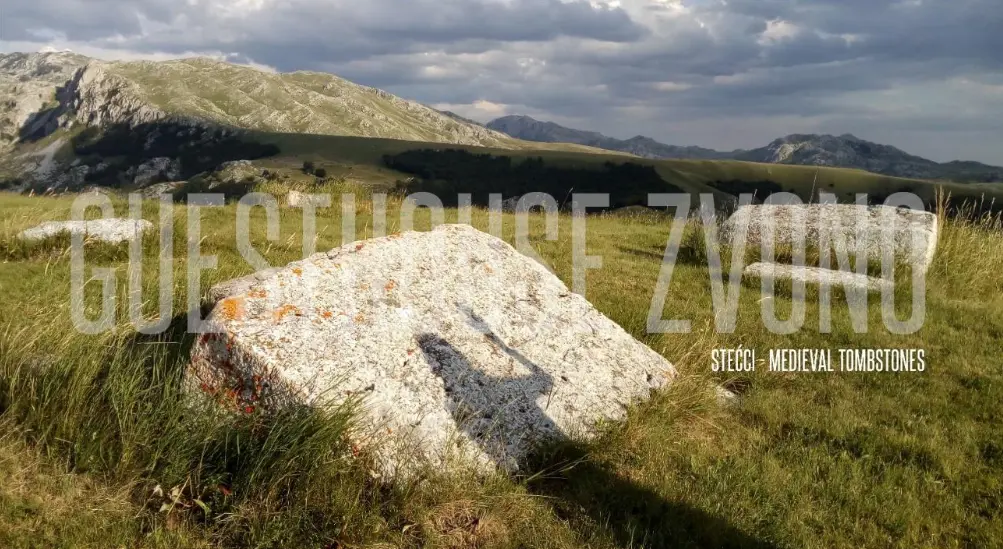Medieval Tombstones in Piva Region
These monuments are historically connected to the culture of medieval Bosnia and authentic Bosnian church (which had a strong influence in this part of Montenegro) and they are evenly distributed over the territory. The necropolises are almost always situated in the isolated places in fascinating natural settings and their position and beauty give us the idea how the Piva inhabitants felt about nature and what their philosophy of life and death was five or six centuries ago. The necropolis Soko grad (near Šćepan Polje) which is located where the fortress with the same name used to be, will soon be on the maps of UNESCO World Heritage Sites, together with thirty other necropolises in the Dinaric area of ex-Yugoslavia.
Our maps will take you to the hidden places where you can enjoy the view of the mountains and the river or lake canyons or where you can take spectacular photos or enjoy the authentic beauty of the monuments or, simply, feel the magic of these spots. The outings will help you understand the literature written in bosaničica (Bosnian Cyrillic) which is preserved on the epitaphs on the tombstones. There are books in our library which can help you with this.
About Bosnian church
This church was first mentioned in the letter of Vukan, king of Duklja, which he sent to the pope Innocent III. In this letter written in 1199 (or 1200), king of Duklja complained to the pope about the hersy in Bosnia that even Bosnian first Ban Kulin supported. Considering the fact that this religion was described as a well-organised order widely accepted by Bosnian people and authorities too, it is assumed that the roots of the heresy in Bosnia date many years or decades before it was mentioned in the letter of king of Duklja.
The believers of Bosnian dualist church are called the Bogumils, the Patarenes, the Manichaeans and the Cathars by different resources. In Italy they are known as the Sclaveni which implies the Slavic origin of their belief (or the origin of the Slavic settles who pracised this doctrine). Some recent resources have described them as Anarcho-Christians. They called themselves Krstjani (Christians).
The Bosnian church was considered to be heretical by both the Roman Catholic and the Eastern Orthodox hierachies. It belonged to the Patarene-Cathar movement which originated in gnostic teaching from the beginning of the first millenium. The gnosticism itself, influenced by ancient teachings, promoted knowledge as a way of liberation from material world. After the appearance of the Iranian prophet Mani (3rd century AD), the gnostics accepted the philosophy of Zoroaster, Buddhism and early Christianity. The root of the prophet's preaching was Dualism and the eternal struggle of good and evil God. It is believed that the Bulgarian priest Bogomil was under strong influence of this movement and that he spread it among the Slavs in the Balkans.
The basic principles of Bosnian Christians' teaching are grounded in the belief that all invisible and spiritual things were created by God (GOOD) while all visible and physical things were created by Satan (EVIL). God has the power over spiritual matters while physical and material matters are controlled by angel Sataniel (evil God) who had been punished and expelled by God.
This church rejected the Old Testament and the books of prophets as well as the mission of John the Baptist and water baptism. They denied that Christ could have died and resurrected. After death, human soul (created by good God) goes to heaven or back to hell on Earth (created by Evil). They also rejected the cross as the symbol of death and suffering. As in Njegoš's poem: "The Crescent and the Cross, great Symbols twain, Do not advantage gain save in the world of slain!" (James W Wiles, originally published in 1930 by George Allen & Unwin, Itd London).
It is noticeable that the cross rarely appears on the reliefs of the tombstones. The carved crosses are usually found on the tombstones which were built later, in the period when this movement gradually lost its significance because of the very agressive attitude od the Orthodox and Catholic churches with South Slavs.
Christians, contrary to the usual doctrine of the Christian church, do not accept the idea that every power is from God. They follow the principles of equality, and they reject strict medieval hierarchy in the state and the church as well. It is believed that this negative attitude to the imposed hierarchy is due to the old Slavic democracy and the way of life which Christians retained to the great extent. In the document from the tenth century it is said that The Bogumils (Christians) "teach their followers not to obey the authority and to criticize the rich".
Bosnian poet said in his poem "House in Milé" :
May the great hiža (house) of our fathers be always open wide
For those who pay no heed to ancient and new tzars
For true kings and false for bans and barons for boyars
For their ample treasure, for many ducats, gold dinars, for that evil money
Mak Dizdar
Christians were against the baptism of children and they received in their community only grown-ups who themselves decided to accept their beliefs. They didn't support any form of violence or duress. They practised vegetarianism. They valued gender neutrality, and both men and women lived together in hiža (monasteries), often with children too and they preached their beliefs equally and freely. It is unique for our region that they had the services in their own language, unlike monotheistic churches. In this way, they encouraged the literacy among the believers. Both the nobility and the common people spoke the same language. Bosnian Cyrillic, the script which we can recognize and read (without much difficulty) on the preserved tombstones today, represented a method of emancipation in this unique religious movement in Europe in those days.
Originally sourced from zvono.me.

